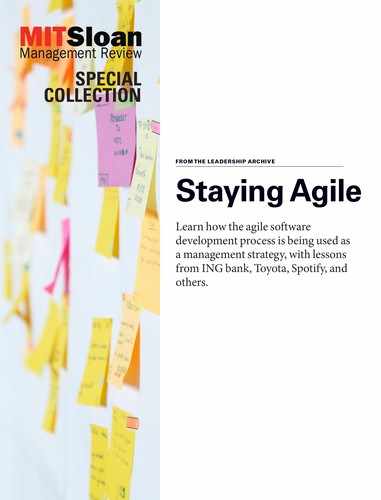Agile practices emphasize process flexibility and the quick delivery of value. This collection of articles from MIT Sloan Management Review looks at how the agile software development process is being used as a management strategy, with lessons from ING bank, Toyota, Spotify, and others.
From “Consider Culture When Implementing Agile Practices”:
- Agile practices help organizations bring products and services to market quickly and enable them to adapt nimbly to changes in the technology landscape.
- A challenge to implementing agile practices globally is accommodating cultural differences. For example, openly expressing thoughts and opinions to authority figures and publicly discussing successes and failures are accepted practices in agile teams, but they may not be consistent with cultural norms in all parts of the world.
- Understanding the unique words used to describe particular behaviors, or the “cultural script” around an action, is an important first step when implementing agile projects outside the U.S.
- To deal with areas where agile practices interact with cultural scripts in atypical ways, companies should maintain flexibility and speed, build an effective agile team, and create accessible communication channels.
From “What to Expect From Agile”:
- Agile emerged during the 1990s as a software development methodology, gathering momentum as a more responsive and collaborative approach to development than the traditional “waterfall” methodology.
- In recent years, agile has moved into mainstream thinking as a management practice.
- A detailed case study looked at the operations of ING bank in the Netherlands, which has adopted agile throughout its headquarters in Amsterdam.
- Five lessons emerged from interviews with 15 executives of the internet banking company. Among them: For agile to work, executives need to figure out how much power they were willing to give up. They also have to give employees the right balance of oversight and autonomy.
From “A New Approach to Designing Work”:
- In applying agile methods from the field of software development to other domains, managers often confuse practices and principles.
- When agile methods work for software development, they do so because the associated practices manifest key behavioral principles — in the context of software development.
- The key to transferring a set of practices from one domain to another is to first understand why they work and then to modify them in ways that both match the new context and preserve the underlying principles.
- By using a dynamic work design, organizations can create their own work processes that are both more flexible and more efficient. An example from a Toyota supplier shows how.
From “Goodbye Structure; Hello Accountability”:
- Well-designed systems can help make a company more agile. But even great processes are responsive to change only if the people who use them recognize what needs to be done and how to do it.
- Organizational structures are designed to clarify how a company will meet stated objectives. They’re not necessarily good at helping people adapt to changing objectives.
- Managers will be able to operate as true digital leaders only when they shake their reliance on structure as the primary tool of organizational design. They instead need to assign accountabilities in ways that instigate focused responses to opportunities.
- For instance, the Swedish streaming entertainment company Spotify supports its customer offerings through the efforts of small autonomous teams. Called squads, these teams define their own missions and develop their own goals, testing and adjusting as they go along.
From “Architect Your Company for Agility”:
- Great strategy is valuable only if a company is capable of executing that strategy, and whether a company can execute its strategy depends on whether it is designed to do so.
- What matters is business architecture — the way a company’s people, processes, systems, and data interact to deliver goods and services to customers.
- To keep pace with customer demand and competitor activity, companies must be able to quickly experiment with a potential offering and, depending on customer response, enrich and scale that offering, or discard it and move on to the next experiment.
- To that end, growing numbers of companies are creating small, cross-functional, agile teams. The concept of continuous release is essential to the effectiveness of these empowered teams. Critically, these teams don’t fear failure.
From “What the Military Can Teach Organizations About Agility”:
- U.S. armed services are experimenting with ways to make faster — and smarter — decisions, and business should take note.
- Once bastions of command-and-control management style, modern military institutions such as the U.S. Marine Corps are at the forefront of thinking about organizational agility. That has been essential in an era of digitally enabled terrorism.
- Military thinking now emphasizes the kind of innovation necessary to move leaders efficiently through the four decision cycles of Observe, Orient, Decide, and Act in order to ensure that forces are best able to respond quickly to sudden external threats.
- For instance, military leaders focus only on decisions they can make, letting teams closest to the problems make decisions and take action decisively and independently.
..................Content has been hidden....................
You can't read the all page of ebook, please click here login for view all page.
